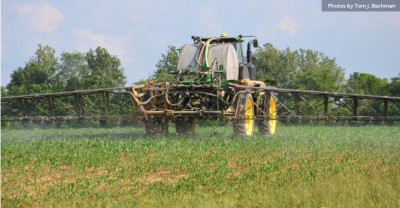Plan now for better 2023 weed control

By Tom Bechman: American Agriculturist
Did you achieve the level of weed control you wanted in corn in 2022? Did you prevent weeds from growing with corn early in the season?
Bill Johnson, Purdue University Extension weed control specialist, says now is a good time to assess how well weed control worked. By evaluating this year's challenges and successes now, you can lay out an even better weed control strategy for 2023.
"A good weed control program in corn should revolve around two key principles," Johnson says. "First, recognize that corn doesn't like weed competition early in the season.
"Most people underestimate how much early-season weed pressure can impact corn growth and final yield. University research over the years documents that early weed competition in corn is usually more damaging to final yield than early weed competition in soybeans. Corn plants sense competition from other plants, including weeds, early, and it can affect growth patterns and plant decisions which impact yield."
The second key principle relates to the growth stage of corn. "After V6, and for sure at V7 and after, herbicide options in corn become limited," Johnson says. "Corn plants make crucial decisions about ear size and kernel set from those stages forward, and most herbicide labels cut off application around that point. You have much fewer options for herbicides if you haven't already controlled weeds."
ADVERTISING
Controlling weeds successfullyEach year, Johnson; Mark Loux, Extension weed control specialist at Ohio State University; and Aaron Hager, weed control specialist at the University of Illinois, discuss weed control issues and make joint recommendations. The result is the 2022 Weed Control Guide for Ohio, Indiana and Illinois.
The guide emphasizes two key steps for weed control in corn, Johnson says. "First, plan a broad-spectrum, residual weed control application," he says. "If you're in no-till, this would likely go on with the burndown application.
"The secret is to apply full labeled rates. With weeds like waterhemp in the mix, you can't afford to skimp on rates and risk not getting the best control possible."
The second step is a timely postemergence application. "Get weeds controlled early, ideally before they're 3 to 4 inches tall," Johnson says.
"Be sure you include more residual herbicide in that post application. Atrazine or an atrazine premix will work in many situations, depending on what you did before. There are other good choices too. Make the application while weeds are small."

These small weeds may look harmless, but weed control specialists insist even small weeds can impact corn yields more than most people think.
Judging weed sizeWould you know a 4-inch-tall weed if you saw one? Take a closer look at the picture below showing 2-inch, 3-inch and 4-inch weeds side by side. They were all pulled from the same location in the cornfield pictured here, with corn at the V4 to V5 stage.
Other weeds were also present. These three are all pigweed species, which includes redroot pigweed and waterhemp.

These three weeds of the pigweed species were pulled from the field pictured above. The tallest is roughly 4 inches. Purdue Extension weed control specialist Bill Johnson prefers taking out weeds as small as 2 inches in corn.
"You definitely want to spray waterhemp plants at 4 inches or less," Johnson says. "The truth is, you ought to be spraying them no matter which species they are by this point.
"Spraying when the biggest weeds are 2 to 3 inches tall in corn would be preferable. You don't want weeds to compete any longer than necessary with corn plants."
Learn to recognize and estimate weed height without the ruler or Coke can present, Johnson says. They're included in the picture to help give perspective and identify actual weed size.
"You can carry a tape measure if you want, but the point is to recognize what small weeds look like," he says. "Many people underestimate how big weeds truly are. You will have better success if you come back with a post pass with residuals in corn when weeds are smaller rather than larger."
Upcoming Events
WNY Pastureland Conversion & Soil Health Field Day
July 16, 2025
Middleport, NY
Join American Farmland Trust for the Western New York Soil Health Field Day on July 16, 2025, at Zeliff Farm in Middleport, NY, from 9:00 AM-3:15 PM. Learn about pasture conversion, soil health benchmarking, biochar in grazing systems, and best grazing practices. Plus, enjoy hands-on demos with the NY Soil Health Trailer, drones, and cover crops! Check out the attached agenda for more information about the field day and REGISTER HERE. Zeliff Farms is a regenerative beef operation who has recently partnered with AFT on outreach and education to farmers including learning circles and evaluating biochar effects on soil health.
IPM Strategies to Protect Corn and Soybean Seed in NY
July 30, 2025
Hamburg , NY
SWNYDLFC and Cornell IPM are hosting a grower meeting to discuss integrated pest management strategies for protecting corn and soybean seed in New York.
FAMACHA Training for Sheep and Goat producers in Woodhull NY
August 13, 2025 : FAMACHA Training in Woodhull
Woodhull, NY
Join us for a discussion and hands-on training for internal parasite integrated pest management in sheep and goats. Certification is available to all students participating in the workshop.
Announcements
No announcements at this time.





